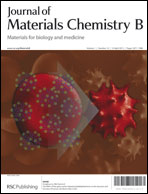Impact of mesoporous silica nanoparticle surface functionality on hemolytic activity, thrombogenicity and non-specific protein adsorption†
Abstract
Although numerous mesoporous silica nanoparticle (MSN) drug carriers and theranostic agents with various surface functionalities have been designed in the last decade, their biocompatibility remains a matter of intensive debate. Here, we systematically evaluated interactions of a series of MSNs possessing different surface functional groups (ionic, polar, neutral, and hydrophobic) with blood constituents, in terms of their hemolytic activity, thrombogenicity, and adsorption of blood proteins on their surfaces. Using a hemolysis assay we showed that surface functionalization can reduce or even completely prevent the hemolytic activity of bare MSNs. We investigated thrombogenicity of MSNs by measuring prothrombin time (PT) and activated partial thromboplastin time (aPTT). We observed that none of the MSNs used in this study exhibit significant thrombogenic activity. Lastly, we examined non-specific protein adsorption on MSN surfaces using human serum albumin (HSA) and gamma globulins (γGs) and found that surface functionalization with ionic groups can greatly reduce protein adsorption. Demonstration of the surface functionalization having a crucial impact on blood compatibility might serve as a guideline for further investigation related to the design of mesoporous silica systems for biomedical applications, and shed light on research towards the ultimate goal of developing smart theranostic systems.


 Please wait while we load your content...
Please wait while we load your content...